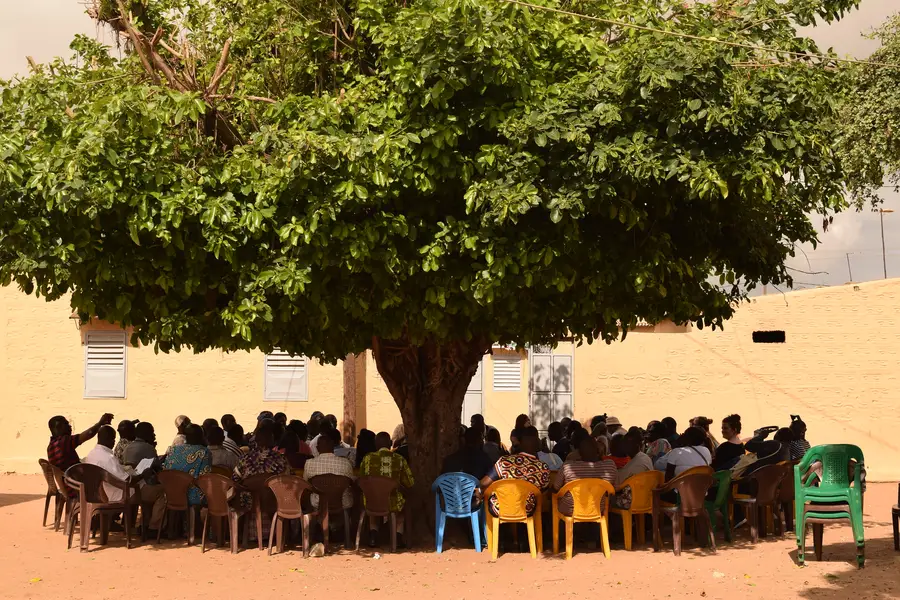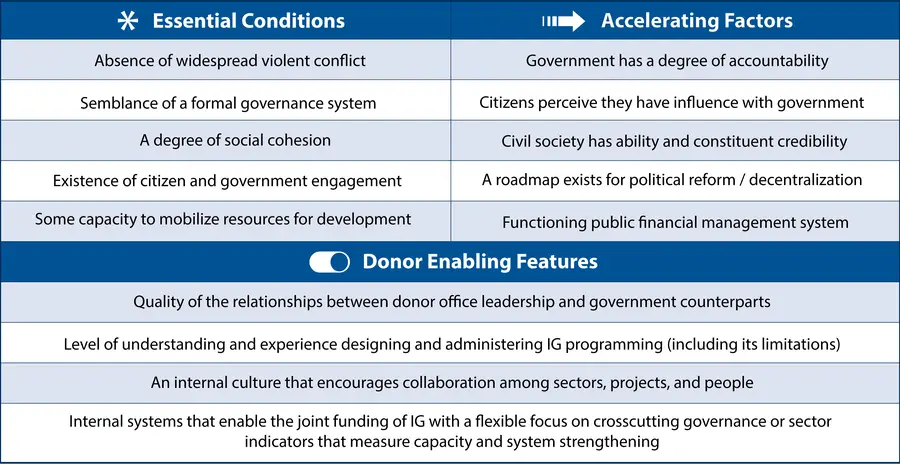
Credit: Shea Flynn for RTI International
As we noted in our first blog—Integrated Governance Best Practices: Then and Now—the concept of integrated governance (IG) has been around for decades, with the most recent iteration embedded in USAID's Democracy, Human Rights and Governance (DRG) Strategy published in 2013.
Later, USAID’s DRG Center identified participation, inclusion, transparency, and accountability (PITA) as critical elements to improve development outcomes, aligned with Doing Development Differently, a global initiative to make development aid more responsive and effective. PITA was also the framework in which USAID worked with Social Impact and RTI International to evaluate and document IG initiatives across six USAID missions (Ethiopia, Guatemala, Indonesia, Malawi, Nepal, and Rwanda), resulting in a case study synthesis report.
This second IG-focused blog is part of a larger research initiative in which we examined 13 projects and interviewed 22 people from USAID and their implementing partners who are knowledgeable about IG issues. Here, we focus on the factors used in selecting, designing, and implementing IG programs. We explore the ‘bread’ (the context and conditions), the ‘main ingredients’ (the design elements), and the ‘special sauce’ (implementation characteristics) from which successful IG programs emerge.
In other words – what is the best mix of ingredients in an IG PITA given the context in each country? Is the country, mission, organization, or project “ready” for integrated governance? What factors will enable or hinder its success?
Our analysis is not meant to be a definitive recipe but instead a new contribution supporting PITA and IG approaches that provides new ideas, lessons, and observations. Our research aims to develop an evidence-based accounting of an IG approach and corresponding design and implementation success factors.
The Bread (Context and Conditions)
In formulating our IG research, we wondered about the following questions:
- Do IG programs work better in some countries than others? And if so, why?
- Are there certain country or donor contexts in which IG programming won’t work?
While interviewing donors and practitioners, we heard different opinions about the ideal conditions for IG programming. They described examples of programs that worked in challenging political environments (such as Burma and the Democratic Republic of the Congo) and those that also succeeded in more economically developed and democratically open countries (such as Indonesia and Senegal).
Our research identified some essential conditions (minimum contextual elements) and accelerating factors (elements that made IG success more likely) to consider when deciding if a country is “ready” or will facilitate the success of IG programming. We also learned what donor features enable IG success.
This collection of conditions, factors, and donor features is neither definitive nor comprehensive. We found that there are, in fact, some instances where IG may be the most effective way to strengthen fundamental PITA systems and processes within even some of the most challenging political contexts.
The Main Ingredients (Design Elements)
Once a donor decides to invest in IG programming, the program plans should be socialized among their stakeholders and their implementing partners. IG projects are ambitious but should also be realistic and achievable. Here are some of the important elements in designing IG programs:
Customized to the Context. It is clear from our analysis that one size does not fit all when it comes to IG programming. We learned that it is vital to customize the ‘recipe’ to fit the country context. In some countries, there may be ample transparency (T) related to government processes and actions but little accountability (A). For example, allegations of corruption may appear in the local newspaper but those responsible are rarely held to account. In other countries, local governments may hold public budget meetings, but few women or youth are invited. Thus, participation (P) exists but there is an absence of inclusion (I).
We believe that it is critical for the donor to undertake an analysis of the state of PITA prior to the design of an IG solicitation, optimally using a political economy lens to deepen the understanding of incentives, barriers, and key stakeholders to facilitate change. In the best of circumstances, this could also be done in consultation with host country counterparts during the development of the Country Development Cooperation Strategy, Business Case, or related overarching donor strategy.
Funding, Scope, and Duration are Key. The projects we analyzed ranged in duration from 3 to 8 years and in value from just under $12 million to $70 million. The longer and higher value projects covered more geography and sector areas than the more modest projects. All IG projects were focused on a single country.
One might assume that the amount of funding is the most important factor to drive results, but we found that duration was equally (or more) important. The longer the project team had to work collaboratively with government counterparts and sector colleagues, the more impactful the results. In terms of scope, it appears that projects that had clearly defined geographies and target sectors could plan more effectively and achieve both governance outcomes and contribute to sector results.
For example, the USAID/Senegal Governance for Local Development (GoLD) program, implemented by RTI, has a modest budget, and although not directly responsible for achieving sector indicators, the GOLD team submits sector activity and accomplishment annexes for health, education, and water and sanitation in all its quarterly performance reports. This is a unique and effective way to maintain a governance focus and results framework, while providing qualitative information on the contributions GoLD is making to improve service delivery in other USAID sectors.
A Healthy Debate about Indicators and Results. Of the 13 IG projects RTI studied, five included only governance indicators while eight had both governance and sector indicators. In addition, eight of the 13 projects could be considered local governance, local development, or decentralization programs while the other five were focused on governance policy or improving service delivery by government entities.
There are often strong opinions as to whether (or at what level) an IG project should be held responsible for achieving sector indicators beyond governance or DRG, such as increased crop yields or children immunized. For example:
- An IG project that is focused too heavily on achieving sector outcomes may lose sight of the core governance issues (like PITA) and system strengthening (such as local revenue mobilization) that are at the core of the original design.
- Governance projects often serve as “accelerators” for sector programs by helping identify and reduce corruption, enhancing local government capacity to plan and budget for sector service delivery, and engaging capable civil society organizational partners in delivering and monitoring sector services. However, the direct impact on sector indicators are downstream results of local stakeholders implementing their own service improvement initiatives.
- Is it reasonable (and fair) for DRG or governance programming, often with the lowest budgets in many missions or country offices, to be expected to not only achieve governance improvements but also specific sector outcomes?
No doubt, this healthy discussion on this point will continue as an increasing number of USAID IG solicitations include ambitious sector illustrative results. At the same time, several practitioners shared that a more reasonable and achievable approach is for IG projects to contribute to improved sector results through supporting capacity and systems strengthening and enabling stronger collaboration among implementers within and between sectors, as well as donor and host country government counterparts.
The Special Sauce (Implementation Characteristics)
In our discussions with Chiefs of Party (COPs), technical and support staff, and USAID personnel, we identified several factors, or implementation characteristics, that make a successful IG program. They include:
The Leader. The role of the COP / Project Manager (PM) is critical because the tone for innovation, outward facing engagement, and adaptability is set at the top. RTI’s experience parallels with much of what we heard in our interviews: that the ideal IG project leader must be
- An exceptional cross-sectoral communicator: This does not only mean interpersonal communication, but the leader should also be able to speak with a degree of technical fluency across several sector areas, including grasping key terminology, concepts, and trends of the different sectors. When communicating the effects of integrated governance in a sector, the leader should use the terms common to that sector and speak about the tangible results to which they are able to contribute.
- Politically savvy, with a deep understanding ofthe country, political, economic, and sector context: Achieving success on a sector program is hard enough, but leading governance programming so that it contributes to more sustainable sector outcomes requires the ability to work within or influence the current system.
- Able to build and manage a team that is complex, complimentary, and collaborative where individuals take initiative and are accountable: The COP / PM must trust the technical experts and partners regarding key decisions and investments. The team must also be able to creatively identify coordination opportunities, conduct effective outreach to different stakeholders, and propose adaptations when initiatives are or are not working.
Level of Coordination. There is a common sentiment among international development professionals that everyone understands the value of coordination, but many are resistant to being coordinated.
To be successful, IG projects must take on the role of initiating coordination among implementing partners and contribute to sector working groups. Coordination works best when it is expected and rewarded by the donor; when it serves a mutual programmatic self-interest (such as efficiency, cost savings or leveraged impact); and when it is not too cumbersome or bureaucratic.
RTI sees an opportunity to work alongside USAID and other IG project implementers to develop, document, and share a living collection of IG coordination tools, ranging from simple listservs to sophisticated management information systems where activity locations, calendars, and performance management plans can be shared among multiple stakeholders.
The Buy-in of Donors. As the funder and overseer of IG programming, it is important that the staff and the sector office leadership within a mission or country office agree on the use, budget contributions, and reporting requirements for IG programs. As USAID’s 2016 DRG integration case study synthesis report pointed out, there are clear factors that enable or derail IG programming, including:
- Policy, strategies, and messaging should encourage or require program integration including requiring it in IP contracts and agreements.
- Strong, supportive, and vocal leadership from the top of the mission or country office and the technical offices to the project level will encourage and enhance coordination.
- If the donor convenes and facilitates information sharing between sectors, this enables and incentives IPs to follow-up on collaboration opportunities that are mutually beneficial.
The Whole PITA
While much of what we have presented in this post is considered good development practice, we believe that there is nuance and new learning and sharing to expand and enhance integrated governance programming. Throughout this post, we identified questions for the reader and areas where we feel that more research and new ideas and instruments are needed. We look forward to engaging with USAID, other donors and organizations that have, are currently, or want to do integrated governance programming so that we can work together to make what we do more efficient, effective, and durable.



